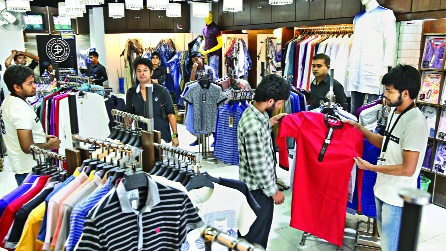Institutional safety monitoring in the country’s ready-made garment (RMG) industry slowed down in recent years, especially after the departure of Accord and Alliance initiatives, which caused rise in the number of workplace accidents.
A latest report of the Centre for Policy Dialogue (CPD) also found that the number of fire accidents in the export-oriented RMG industry increased to 241 in 2022, which was 180 in 2021, and 177 in 2020.
The number of workers’ death in workplace accidents in the RMG industry, however, decreased to four in 2022 from 13 in 2021, it showed.
Uncertainties over maintaining the progress in terms of factory remediation – made by the two western buyers’ platforms Accord and Alliance – have arisen after their departure, the CPD said in a media briefing at its office in the city on Wednesday.
CPD Research Director Dr Khondaker Golam Moazzem and Senior Research Associate Tanim Ahmed jointly presented findings of the report – ‘Monitoring Workplace Safety in the RMG Sector: Is Bangladesh a Pioneer or Still a Learner?’
Citing statistics of the Bangladesh Fire Service and Civil Defence, the report showed workplace accidents in the RMG industry continue to take place in 2023 as well.
A garment worker in an export-oriented garment factory died when a wall of the building collapsed on February 19. Besides, fire broke out in a factory on May 1, in which at least 18 employees suffered burn injuries.
The CPD report also showed that accidents occurred in at least three export-oriented RMG factories, where the RMG Sustainability Council (RSC) conducted workplace safety inspections.
The CPD, however, said the biggest success of the Bangladesh RMG industry in the area of workplace safety was to be able to ensure no repetition of Rana Plaza-like incidents in the past 10 years.
It also said the number of accidents decreased during safety inspections conducted by the European Union-based buyers’ platform Accord on Fire and Building Safety in Bangladesh and the United States-based buyers’ platform Alliance for Bangladesh Workers Safety.
Since the two initiatives are no longer active here, the Department of Inspection for Factories and Establishments (DIFE) along with RSC and Nirapon, the successors of Accord and Alliance, must continue the safety standard set by the global initiatives.
“In fact, in view of a few recent incidents in the garment industry, it has become crucial to review whether the existing safety monitoring entities are in the right direction or not.”
The CPD report showed that despite increasing technical and institutional capacity, the DIFE’s number of safety inspections in RMG factories decreased to 3,560 in 2022, from 6,227 in 2021.
“It is unclear what caused the decrease in inspections for the RMG industry, particularly when the scopes of inspections remain higher with introduction of the digital Labour Inspection Management Application (LIMA).”
Expressing concern over the DIFE’s increasing tendency to keep the disclosure of information at a minimum level, the CPD said it was an impediment for making the government agencies concerned accountable.
Following the Rana Plaza collapse in 2013, safety inspections were conducted in 1,549 factories under the government-led national initiative. The number of factories under the initiative dropped to 659 as of October 2022, as a number of units had to shut their operation due to non-compliance and financial crisis following the Covid-19.
The government, in association with the International Labour Organisation (ILO), formed the Remediation Coordination Cell (RCC) to oversee safety progress in the factories inspected under the initiative.
After the RCC’s operation had ceased, the responsibility of overseeing remediation of the factories was shifted to the Industrial Safety Unit (ISU) under the DIFE.
The ISU is yet to start its operation, and remediation progress for the factories under the national initiative remained stagnant at 54 per cent over the years, according to the CPD report.
In June 2020, the RSC was set up to act as the national initiative that would implement programme of the former Bangladesh Accord, now the International Accord.
The report showed that the RSC already covered 1,887 factories as of June 2023, and remediation progress in the units stood at 91.32 per cent.
It also observed a sharp decline in follow-up and other inspections in the RSC-covered factories in this April.
“The decline in these specific types of inspections may not necessarily indicate an overall reduction in the RSC’s inspection activities. Nevertheless, an over 50 per cent decline in follow-up and other inspections compared to the previous months raises concerns.”
Citing the data of Mapped in Bangladesh, a digital database of the RMG factories and workers, the CPD said of the country’s 3,752 active garment factories, some 1,887 factories are covered by RSC, 350 by Nirapon, and 659 by RCC.
“There are at least 856 RMG factories, which are not under the purview of any inspection mechanism at present,” Dr Moazzem said.
The government should develop safety standards for all the export-oriented RMG factories, and compliance should not be the US and the EU market-based.
He suggested gradually bringing those units under the membership of either BGMEA or BKMEA by offering associate membership initially – as an interim mechanism to bring those under regulation.
CPD Executive Director Fahmida Khatun said ensuring compliance in the RMG sector is important for Bangladesh, as the country’s export earnings largely depend on the sector.
After graduation from the least developed country to a developing one, labour-related compliance would be crucial for Bangladesh to gain the GSP plus facility in the EU market, she noted.
Munni_fe@yahoo.com
News Source


























